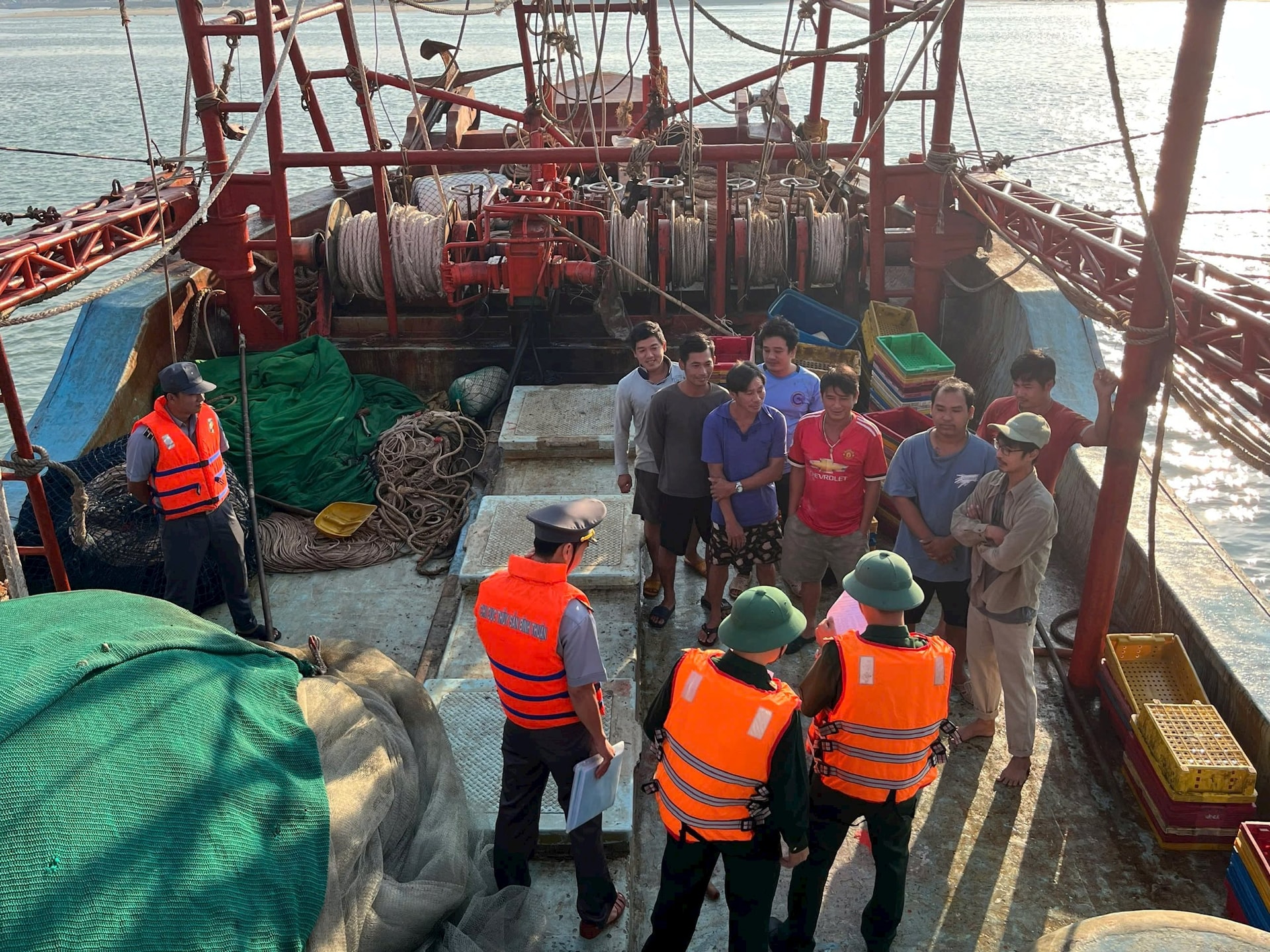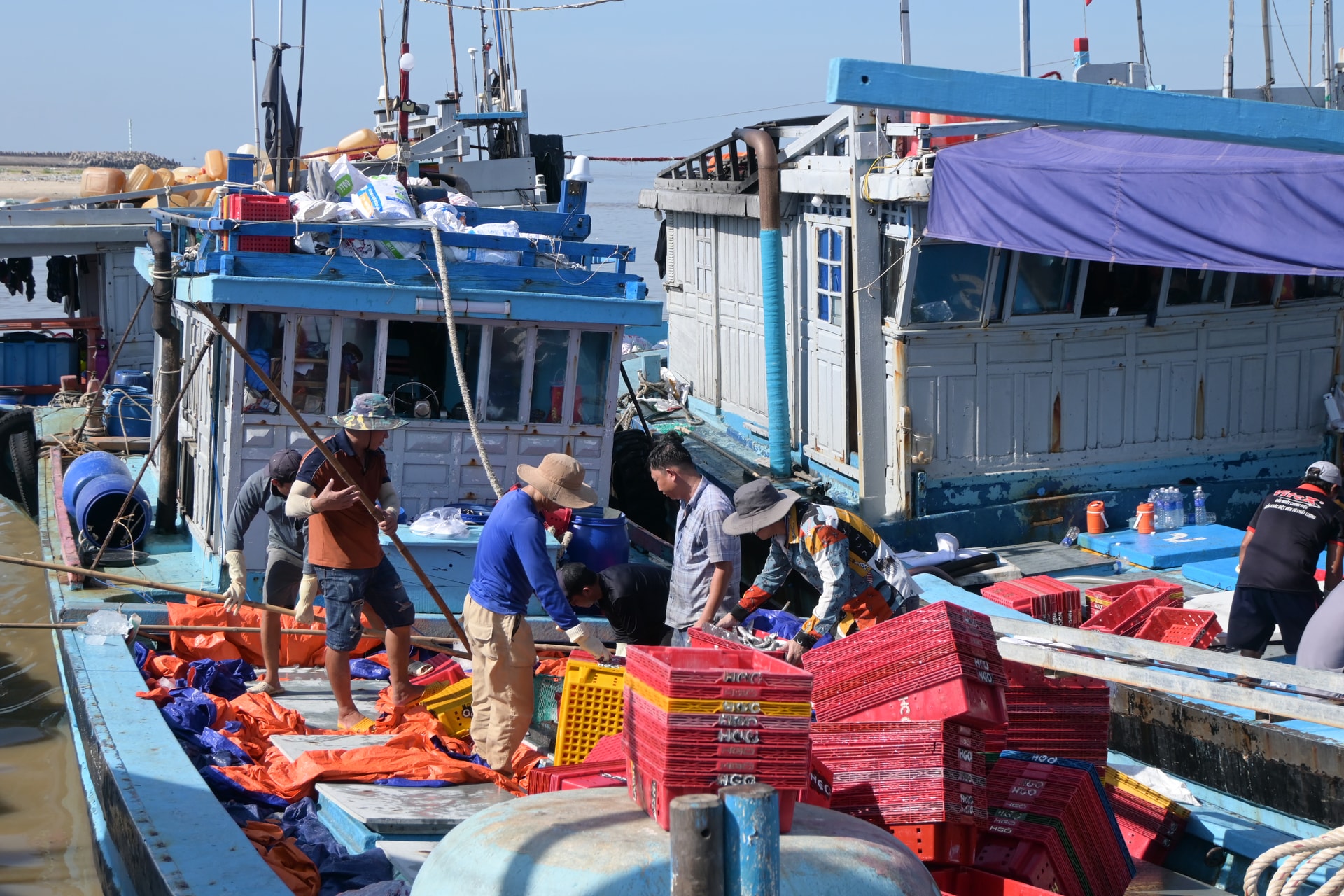
Fishing boats entering and leaving port are still low.
According to the provincial Department of Agriculture and Environment, despite increased propaganda, the rate of fishing vessels entering/exiting ports and leaving ports is still low compared to the total number of registered fishing vessels. Since the beginning of the year, the provincial fishing port management board has counted 43,190 fishing vessels arriving/leaving ports, monitored 33,564 tons of seafood unloaded through the port; collected 15,237 fishing logbooks (reaching 89.6% of vessels arriving at ports to unload products). In particular, 28,997 fishing vessels have been confirmed to arrive and leave ports through the electronic seafood traceability system (eCDT), issued 35 certificates of origin/more than 345 tons of seafood of all kinds through the eCDT system, mainly Phan Thiet Fishing Port issued 30 certificates/nearly 277 tons.
Recorded on the morning of September 12, from early morning, Lam Dong fishermen's boats loaded with mackerel arrived at the shore, signaling the main fishing season. At 8 am, Phan Thiet Fishing Port (Phan Thiet Ward - Lam Dong Province) was very busy as boats continuously docked with full holds of fish.
Creating a source of “clean” and transparent raw materials in seafood exploitation is of great significance, contributing to improving competitiveness, facilitating product traceability, meeting the requirements of import markets, especially the EU in the process of removing the IUU “yellow card”. At the same time, strict control of raw materials also contributes to protecting aquatic resources, legal exploitation, towards sustainable fisheries development, harmonizing the interests of the state, businesses and fishermen.
Ms. Nguyen Thuy Quy Tu - Head of the Department of Quality, Processing and Market Development, Department of Agriculture and Environment of the province.
However, the work of controlling the origin of aquatic products, the output monitored through the port only accounts for a small proportion compared to the total output. With a fleet of more than 8,400 vessels with a length of 6 m or more (of which more than 2,000 vessels are 15 m or more in length), but only about half of them dock at 4 fishing ports in the province including: Phan Thiet Port, Phu Hai Port, Phan Ri Cua Port and La Gi Port to sell products, of which only 2 fishing ports have been announced by the Ministry of Agriculture and Environment as fishing ports with a sufficient system to confirm the origin of aquatic products from exploitation (Phan Thiet Fishing Port from November 2020 and Phu Hai Fishing Port from December 2024). The remaining vessels mostly go to the beaches and temporary wharves such as: Mui Ne, Ke Ga, Tan Thang, Phuoc The... to sell fish, get fuel, then go to the designated fishing port to carry out import and export procedures.
This has led to difficulties for businesses and seafood purchasing and processing facilities in the province in finding “clean” raw materials for export. Many fishermen said that if they dock at a designated port, the captain must notify the fishing port management board 1 hour in advance so that they can check the VMS equipment and many other types of documents and procedures. If they are not guaranteed, the ship will not be allowed to dock, so the fishermen will not be able to sell their products. Because of these problems, most of them bring their ships to temporary docks or beaches to make purchasing seafood more convenient, if they do not need to confirm the origin of the seafood output for export.
Since Vietnam's seafood products were given a "yellow card", seafood processing and exporting enterprises in the province have faced many difficulties. The whole province has 26 enterprises/34 processing workshops that export seafood products to foreign markets, of which 5 enterprises export directly to the EU. Ms. Nguyen Thi Nga - Deputy Head of Quality Management Department of Hai Nam Co., Ltd. shared: "If in the past, the company exported 50 - 70% of orders to the EU, mainly focusing on items such as: squid, octopus, fish of all kinds..., now it is only about 10%, because it is very difficult to find "clean" raw materials. Most companies buy raw materials from wholesalers, however, these wholesalers do not fully understand the regulations on combating IUU fishing, so they do not fully meet the procedures and documents to make certificates of seafood origin (SC, CC)".

Businesses in trouble
This enterprise added that according to the provisions of the Fisheries Law 2017, for ships with a length of 15 m or more, the captain must comply with the procedures when docking at the designated port, so that the competent authority can check and control the records, fishing logs, and monitor the operation of the voyage monitoring equipment... If just one of the above conditions is missing, the output will not be granted SC or CC certificates. In addition, the procedures for exporting raw shrimp to the EU market are also being congested, because shrimp is a special seafood species that is exploited near shore by small basket boats, does not require a fishing license and does not require the installation of VMS equipment. Therefore, these raw materials are not eligible for SC and CC certificates for export to Europe according to current regulations.
Not only Hai Nam Company has difficulty in implementing traceability procedures, the representative of Muoi Tuyen Company Limited added: "Fishermen do not understand the regulations on IUU, so they are afraid to keep fishing logs, do not record details of species and fishing areas for fear of revealing fishing ground information. Therefore, inshore fishing vessels are ready to sell to purchasing establishments without any requirements or demands regarding paperwork...".
This shows that the link between fishermen and businesses is still loose, mainly based on free trade, lacking long-term commitment, leading to local shortages of raw materials. In addition, major import markets (EU, US...) are increasingly tightening IUU regulations, putting great pressure on local production, processing and export activities.
Faced with that situation, seafood exporting enterprises in the province hope that the relevant authorities will have policies to upgrade the infrastructure of fishing ports, so that large vessels operating purse seine and seine nets for offshore fishing can easily dock and have places to anchor and unload to increase purchasing output. Announce more fishing ports that are qualified to confirm the origin of exploited aquatic products according to regulations. In addition, management agencies also need to build and provide complete and public data on fishing vessels, and have appropriate support policies for facilities applying the IUU raw material control process. In particular, the biggest difficulty at present still lies in the awareness of fishermen. Therefore, it is necessary to regularly propagate and guide fishermen to keep full fishing logs, maintain VMS equipment to carry out traceability procedures, and comply with regulations against IUU fishing...
Seafood traceability is the process of tracking and recording the entire history of a product from the time it is harvested or farmed until it reaches the consumer, to ensure food safety, sustainability and information transparency. The electronic traceability system (eCDT) is being deployed in Vietnam, which is also a condition for removing the “yellow card” according to EC regulations.
Source: https://baolamdong.vn/kho-go-the-vang-iuu-khi-ngu-dan-con-ne-cang-chi-dinh-392410.html




![[Photo] Da Nang: Hundreds of people join hands to clean up a vital tourist route after storm No. 13](https://vphoto.vietnam.vn/thumb/1200x675/vietnam/resource/IMAGE/2025/11/07/1762491638903_image-3-1353-jpg.webp)














































































































Comment (0)